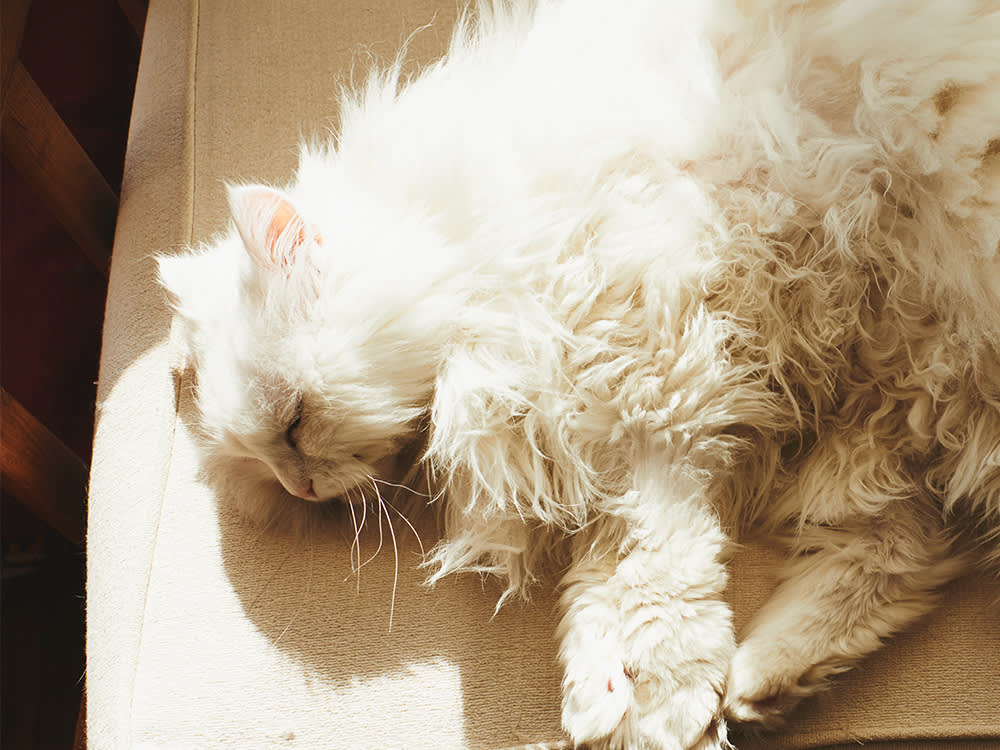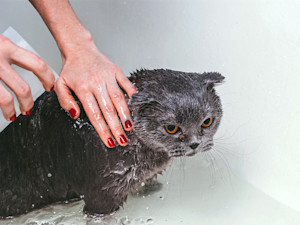Let the Cat Fur Fly
A professional groomer sheds some light on how to keep cat hair under control.
Cat hair has this bizarre quality of being everywhere and nowhere at once — you can’t miss it, but try to remove it and it magically reappears. We caught up with Kara Redden, veteran groomer and manager at Aussie Pet Mobile, to learn more about the phenomenon that is cat shedding and, more importantly, how you can handle this hairy situation.
So why do cats shed?
Cats shed to rid themselves of dead hair (just like people do ) and make room for new strands to come in. Shedding rates depend on the climate you live in, your cat’s breed, their health and diet, and if they are an indoor or outdoor cat (the former tend to shed more steadily year round). “A few fine hairs is normal but constant digging, scratching, or clumps of hair falling out is unusual,” says Redden. “Sometimes shedding [to this extent] can indicate kidney, liver, or skin issues.” Keep tabs on your cat’s shedding patterns (do your best) and call your vet if you notice any bald spots.
Save on the litter with color-changing tech that helps you better care for your cat.
Shouldn’t self-grooming take care of all that hair?
It’s true, cats preen themselves like their lives depend on it, but sometimes even they can’t keep up with the sheer amount of fur that they produce. “Not all cats are able to adequately self-clean, whether it’s because of age, disability, or weight,” Redden says. “Sometimes a cat, especially longhaired breeds, can’t get close enough to their skin.” Ineffective self-grooming leads to excessive hair and those dreaded hairballs which are unpleasant for all parties.
What can I do to manage the shedding?
Brushing your cat regularly will cut down on the volume of hair they inevitably ingest while self-grooming and the amount that you’ll have to scrape out of your carpet. Some cats actually enjoy being brushed but if yours gets scrappy, try chilling them out first with catnip or CBD.
Should I bathe my cat?
That depends. If you have an older cat that is no longer up to the task of self-grooming, a bath could loosen trapped hairs and prevent matting. Similarly, if your cat has allergies or a skin condition, your vet might recommend regular baths.
Can I take my cat to the groomer?
Just like dogs, cats can benefit from a good professional grooming service. In addition to bathing and brushing, groomers clip claws, clean ears, and polish teeth. “Routine grooming helps prevent matted fur, dander, dry skin, and the potential for skin irritation and infection,” says Dr. Caity Flint, DVM. “This is especially true in breeds with longer fur or overweight cats that cannot reach certain areas. Plus, outdoor cats can track in debris or harbor insects.”
My house is already covered in cat hair. Help.
Fear not. For starters, vacuum often, preferably with a machine designed with cat hair in mind. Do your best to reduce clutter on floors and surfaces as nooks and corners are notorious hair hiding places. Static electricity also makes cat hair cling to material, so add an anti-static spray, a grippy tool like a squeegee, and a rubber carpet broom to your shopping list. Finally, dry air can make cat hair stick to its surroundings with particular enthusiasm so here’s a tip: try turning on the humidifier or misting cat hair with a spray bottle before you wipe it up. You’re welcome!





